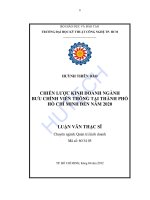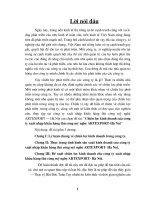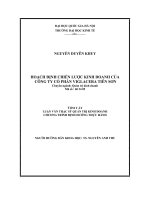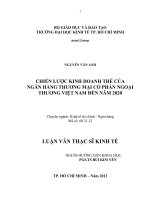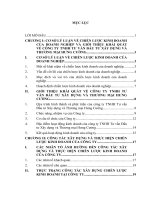Luận văn thạc sĩ chiến lược kinh doanh của công ty PVFC giai đoạn 2015 2020
Bạn đang xem bản rút gọn của tài liệu. Xem và tải ngay bản đầy đủ của tài liệu tại đây (913.02 KB, 84 trang )
LUÂN VĂN THẠC SĨ
Chiến lược kinh doanh của công ty PVFC giai đoạn 2015-2020
THESIS
BUSINESS STRATEGY OF PVFC
IN THE PERIOD FROM 2015 TO 2020
Strategic Management
ACKNOWLEDGEMENTS
2
Strategic Management
INDEX
Page
List of tables ....................................................................................................5
List of figures .................................................................................................. 5
Appendices ................................................................................................................. 6
List of abbreviations .......................................................................................6
Introduction..................................................................................................... 7
Chapter I. ARGUMENTATIVE BASIS FOR BUSINESS STRATEGY
OF PVFC .........................................................................................................9
1.1. Some basic issues relating of business strategy .................................... 9
1.1.1. The concept of business strategy .......................................................... 9
1.1.2. Basic characteristics of the business strategy ........................................ 10
1.1.3. The role of business strategy ...........................................................10
1.1.4. Strategic planning process .................................................................. 11
1.2. Steps in establishing business strategy ................................................ 12
1.2.1. Vision and mission ............................................................................... 12
1.2.2. Strategic objectives .............................................................................. 12
1.2.3. Analysis of external enviroment .............................................................. 13
1.2.3.1. Macro enviroment ...................................................................13
1.2.3.2. Industry analysis and competitiveness ....................................... 17
1.2.4. Internal elements ..................................................................................... 20
1.2.4.1. Strengths and weaknesses ................................................................ 20
1.2.4.2. Sustainable competitive advantage .........................................21
1.3. Using strategic analysis tools ................................................................22
1.3.1. Space matrix ...............................................................................................22
1.3.2. Swot matrix ................................................................................................23
1.4. Strategy options .....................................................................................25
3
Strategic Management
1.4.1. Best-cost provider strategy ........................................................................25
1.4.2. Differentiation strategy ..............................................................................26
1.4.3. Focused strategy ..................................................................................... 26
1.4.4. Strategies combination ............................................................................ 27
Chapter II. ESTABLISHING AND DECIDING BUSINESS STRATEGY
OF PVFC IN THE PERIOD FROM 2015 TO 2020 ................................ 29
2.1. Brief introduction about PVFC ........................................................... 29
2.1.1. Foundation and development .................................................................... 29
2.1.2. Functions and duties of PVFC ...................................................................30
2.1.3. Business performance in 2007 - 2009 .......................................................32
2.2. PVFC’s business strategy................................................................................. 36
2.2.1. Development strategy of PVFC until 2015 and its orientation to 2025 ....36
2.2.2. PVFC’s strategic analysis ..........................................................................39
2.2.2.1. Swot analysis ......................................................................................40
2.2.2.2. Space analysis ......................................................................... 47
2.3. Deciding business strategy................................................................................48
2.3.1. General strategy ..............................................................................48
2.3.2. Deciding business strategy ........................................................................ 49
Chapter 3. RECOMMENDATIONS AND SOLUTIONS TO BUSINESS
STRATEGY IMPLEMENTATION AT PVFC ........................................ 50
3.1. Solution to organizational management ..............................................50
3.1.1. Solution for the organizational model .......................................................50
3.1.2. Suggestions for the Human Resources Division ............................. 50
3.1.2.1. Training ..............................................................................................50
3.1.2.2. Recruitment ........................................................................................ 52
3.1.2.3. Policy for employees ............................................................... 52
3.2. Solution for information technology ....................................................53
3.3. Controlling solution ...............................................................................53
4
Strategic Management
3.4. Business solution ....................................................................................54
3.5. Solution for services............................................................................... 55
3.6. Some petitions.........................................................................................55
3.6.1. Choose recruiment methods ...................................................................... 56
3.6.2. Policies to attract talents ...........................................................................57
3.6.3. Hire consultants ......................................................................................... 57
3.6.4. Training and retraining ..............................................................................57
3.6.5. HR development ......................................................................................... 58
3.6.6. Public, democratic selecting titles .............................................................59
3.6.7. Promotion, demotion, rotation ...................................................................60
3.6.8. Apply fair methods of work assessment, appropriate distribution ..60
3.6.9. Ideal and popular business culture ........................................................... 62
Conclusion .....................................................................................................65
References .................................................................................................... 67
Appendices ........................................................................................................... 69
5
Strategic Management
LIST OF TABLES
Page
Table 1.1: SWOT matrix table.................................................................................. 24
Table 1.2: Type of competitive advantage being pursued ............................. 25
Table 2.1: Achievement of the production and business targets of PVFC in 2007 . 32
Table 2.2: Achievement of the production and business targets of PVFC in 2008
.........................................................................................................................32
Table 2.3: Achievement of the production and business targets of PVFC in 2009.33
Table 2.4: Qualification Report of HR to 31/12/2009 of PVFC .......................... 34
Table 2.5: Qualification Report of HR to 31/12/2009 of PVFC .......................... 34
Table 2.6: Ranking the opportunities ..............................................................40
Table 2.7: The impact evaluations of threats towards PVFC................................41
Table 2.8: Determining the steady competitive advantage ............................45
Table 2.9: Strengths and weaknesses .............................................................45
Table 2.10: Score for the factors ....................................................................... 47
Table 2.11: The matrix for choosing strategy ................................................. 49
LIST OF FIGURES
Page
LIST OF ABBREVIATIONS
MBA: Master of Business Management
PVFC: PetroVietnam Finance Corporation
HR: Human Resource
HRM: Human Resource Management
FDI: Foreign Direct Investment
ID: Identify
6
Strategic Management
PR: Public Relation
WTO: World Trade Organization
7
Strategic Management
Introduction
In the competitive business world, some companies are successful while
others fail? Each enterprise has unique reasons for survival and growth. This generally depends on the
strategy of each enterprise, while other factors, such as location and viable markets are also important,
strategy and planning remain paramount.
Strategy consists of ideas and plans enabling a business to compete successfully. The Master of
Business Administration (MBA) training course equips students with the basic knowledge to have a strategic
business vision for the company. All we learned stresses the relativity and interdependance of factors, which,
in turn, provided us with an important overview of all aspects. However, because of the limitation of time
and human resources, the research is limited to The Petrovietnam Finance Company’s (PVFC) business
strategy from 2010 to 2015.
Reasons for choosing this topic:
Businesses have access to resources such as materials, equipment, cash, and
people in varying degrees. The success of a company depends not only on good
management but also on appropriate business strategies – how the resources are
used.. Therefore, strategic management plays an essential role in maintaining a
competitive advantage and achieving success.
Viet Nam has recently moved away from the ‘centralized planning’ model as
defined in Marxist economic theory, to a capitalist market economy. State
enterprises have been restructured as ‘joint stock companies’. Business leaders have
had to change methods of management and administration to meet new conditions,
such as competitiveness, and the challenges of globalization. Marxism has led to
dependence on the State for strategy, and consequently, has resulted in stagnation and lack of dynamism. In
particular, this study offers solutions for human resources management as part of the business strategy.
The purpose of subject research of the group:
Based on the knowledge gained and the business strategy of PVFC, our
group would like to recommend, evaluate and make suggestions for PVFC to
implement its business strategy successfully.
Object of research:
8
Strategic Management
The analysis of the internal and external environment as well as the business
situation helped PVFC establish its business strategy in the period of 2010 – 2015.
Scope of research:
Establishing business strategy of PVFC in the period od 2010 -2015.
Research methodology:
Researching and studying the related materials in Vietnam and
internationally.
Consultation with experts in relevant fields.
Investigating situation and materials of PVFC.
Consulting relevant experts.
Structure
Chapter I: Argumentative basis for business strategy of PVFC.
Chapter II: Establishing and deciding business strategy of PVFC in the period from
2010 to 2015.
Chapter III: Recommendations and solutions to business strategy implementation at
PVFC.
9
Strategic Management
Chapter I
ARGUMENTATIVE BASIS FOR BUSINESS STRATEGY OF PVFC
1.1. Some basic issues relating to business strategy
1.1.1. The concept of business strategy
Threlar said "business strategy is an art that businesses use against the
competition to win".
Parter said: "Strategy is the art of building competitive advantage for a firm
defense".
These authors consider business strategy as the art of competing in the
market to develop business.
Arlleret said "Strategy is the determination of roads and other means to
reach the goals identified through the policy".
Bizrell said "strategy as a general plan or direction of the enterprise lead to
the desired target. It is the basis for the policies and the operation mechanism ".
Gluecl said: "Strategy is unification, comprehensive synthetic plan to be designed to ensure that the
objectives of the business will be carried out".
Accordingly, the combined point of view is:
"Business Strategy is the art of coordinating activities and controlling them in order to reach the
long-term goals of the enterprise”.
Chandler considers strategy as encompassing the assigned long-term goals of the business base, and
the selection process or how to act and allocate the necessary resources and organize the implementation of
the objectives. "Business strategy is an art to design, organize the means to reach the long-term goals of the
company and it’s relevance with the transformation of the business environment and competition”.
1.1.2. Basic characteristics of the business strategy
Business strategy clearly defines the objectives and basic directions of
business enterprises in each stage.
10
Strategic Management
The nature of strategy is to ensure business continuity and development in a
constantly fluctuating business environment.
Business strategies ensure maximum mobilization and combine optimal
exploitation and use of the enterprise resources in the present and future, and
promote the advantages and seize opportunities to gain advantage over the
competition.
The business strategies of an enterprise are reflected throughout the organisation.
Businesses strategies are always aggressive so as to win in the marketplace.
Business strategies are often built over a long period (3, 5, 10 years).
1.1.3. The role of business strategy
Business strategy helps businesses to identify their purpose, gives direction
to their work, and guides the production and business activities of enterprises.
Business strategy helps companies to take advantage of business
opportunities, and proactively take measures to overcome the risks and threats in
the market.
Business strategy contributes to the efficient use of resources, strengthening
the competitive position of enterprises and ensures the sustainable development of
enterprises.
Business strategy creates a solid base to set out policies and decisions for
production and business in accordance with fluctuations in the market.
11
Strategic Management
1.1.4. Strategic planning process
Function-tasks and strategic goals of the
enterprise (1)
Business environmental
analysis (O,T) (2)
Internal analysis of the
enterprise (S, W) (3)
Strategic Selection (4)
Corporate-level Strategy (5)
Business establishment strategy and
functional division
Strategy implementation (6)
Test and evaluate the implementation
results (7)
Feedback
Figure 1.1: Strategic planning process
Source: The lectures on Strategic Management. International MBA
Training Program - Ngo Kim Thanh, 2009
12
Strategic Management
1.2. Steps in establishing business strategy
1.2.1. Vision and mission
* Vision
Vision refers to the direction of the organization... As a means of setting a
central goal that the organization will aspire to reach.
Vision includes 2 parts:
- Core ideas.
- Future vision.
The core ideas determine long – term identity of an organization. This is the
consistent determination, beyond the life cycles of products in the market, advanced
technology, management styles and the leaders.
The future vision includes 2 parts: the purpose from 10 to 30 years and a
description of how the goals are reached.
* Mission
A mission statement is a formal written statement describing the purpose of
the company. The mission statement should guide the actions of the organization,
spell out its overall goal, and provide a sense of direction, a guide for decisionmaking. The mission is the focus that liberates the organization's potentiality,
represent the competencies required to reach the goal in the certain period of time.
1.2.2. Strategic objectives
Strategic objectives are the milestones that the corporation wants to reach in
the different periods of time. It is significantly important for any company to
determine strategic objectives.
The strategic objectives are various and classified as following :
- Based in time, the short – term or long – term objectives.
- Based on the nature of objectives: economic objectives, political objectives
and social objectives.
- Based at levels: business level, business unit level or functional level.
13
Strategic Management
- Based on the forms of expression of the objectives: oriental objectives or
quantitative objectives.
- Based on growth factors: increasing or static, or even decreasing market
share.
The main objective of any business is to have consistent growth in the
market place. However, it may be measured differently depending on conditions.
The author Peter Drucker suggests the short – term and long -term objectives as
follows:
- Business market share;
- Profit;
- Ressources distribution and risks;
- Productivity;
- Competitive advantage;
- Human resource development;
- Social responsibilities.
Strategic objectives depend on the environment and business capacity in
general. Good objectives are both strategically offensive and feasible. In order to
meet requirements, the determination of objectives needs the following basis:
- Business mission of the enterprise in general and in specific strategic
phases;
- Business philosophy (mentioned in the business mission);
- General judgment of the business environment and capacity.
1.2.3. Analysis of external environment
1.2.3.1. Macro environment
* Economic elements
The macroeconomic environment determines the prosperity of the economy,
which affects enterprises and industries. Therefore, it is essential for any enterprise
14
Strategic Management
to study the economic environment in order to recognise the changes, trends and
strategic implications.
Economic factors strongly affect business operation through the fluctuation
of macro economic variables as well as macroeconomic policy as determined by the
government. Some factors taken into consideration are:
• Growth trends of GNP or GDP;
• Inflation and price fluctuation;
• Balance of payments;
• Interest rate and its trends;
• Exchange rate and currencyfluctuations;
• Individual income levels;
• Corporate tax policies.
The four most important factors of the macroeconomic environment are:
- Economic growth;
- Interest rates;
- Exchange rates;
- Inflation.
* The technological element
Technological changes affect many aspects of society. These effects are
influenced by products, technological processes and new materials.
The technology plays an important role in creating new products, in forming
new processes, and creating satisfaction. These have an impact on the competitive
advantage of the enterprises. The impact includes:
- The current capacity of the infrastructure of the national economy.
- The strategy to develop the technological sciences and resources to
implement this strategy.
- The investment in research and development in industry and the economy.
- The ability to apply advanced technology and mechanization to industry.
- Accomplishment of technology conversion in the national economy.
15
Strategic Management
- The regulations for intellectual property rights and the application in the
real situation.
Those are extremely active factors that bring many
opportunities to
enterprises. On the other hand, they create new challenges to business operations.
* Social and cultural environment
Like the technology changes, the changes in society and culture also provide
opportunities and threats.
The social and cultural elements include:
- Population and its fluctuation trend;
- Households and mobilization trend;
- Movement of inhabitants;
- Religion;
- Life styles and living attitude;
- Women in the labour force;
- Occupation;
- Spending patterns.
Also, the society and culture have a big impact on establishing the
organizational culture, the relationship with partners and customers.
The reason why enterprises take these changes into consideration is that they
want to recognise buying trends and buying behaviors so that they are able to decide
the appropriate business strategy.
* Demographic elements
The demography refers to population, age structure, geographic distribution,
ethnicity and income distribution. This should be analysed globally because it
impacts can exceed the national frontiers.
Some aspects of the demographic environment are:
- Scale: total population, total labour force;
- Structure: The fluctuations of population, age, sex, religion, etc;
- Quality: ability, education, competence, etc;
16
Strategic Management
- Occopation, Income level;
- Territory distribution.
These natural elements not only play an important role in influencing on
people life but also affect the determination of business strategy.
* Political elements
The political and legal systems impact tremendously on opportunities and
include threats from the external environment. The effects include the government
policies, the legal system and population distribution, especially the domestic and
international business laws. These include:
- The stability of the political system and international policies;
- The balance of payments;
- The economic development of the government;
- The adjustment and the intervention in the social and economic activities
- The legal system and its implementation in the economy.
* Globalization
The global environment relates to the
significant international political
developments, the institutional features and the fundamental culture in the global
market.
Globalization creates both opportunities and challenges. All of these changes
strongly influence the enterprises and bring many opportunities to the business
arena. Globalization is the first element that affects strategic management. Some of
the elements are asfollows:
- The impact of international politics;
- The effect of the international economy;
- The effect of the international laws and regulations;
- The effect of the international technology;
- The effect of the international culture.
Therefore, the main purpose of macroeconomic
analysis is to identify
changes, and trends affecting the business operation. focussing on this analysis
17
Strategic Management
allows enterprises to realize opportunities and threats so that the enterprise would
be able to deal with problems and promote business production activities.
1.2.3.2. Industry analysis and competitiveness.
Industry includes many companies that provide goods and services. In the
competition, the companies in the same industry have mutual impacts, but each
industry has various competitive strategies that companies pursue in order to reach
profitability.
The industry and competitiveness analysis examines the following:
- Significant features of the industry
- The competition from rivals, their nature and strengths
- The impacts of industrial changes and their effects
- The strengths and weaknesses of other companies
- The company that might create the movements in the same industry
- The key factors for the success and failure in the competition
- The attraction of above average profits in the industry
* Porter’s five forces model
Porter, the analytical of strategist at Harvard Business Administration
University mentioned the model which might help the managers identify
opportunities and threats. (Michael E. Porter, Competitive Stratery, New York:
Freepress, 1980). Five forces model presented in the following diagram:
18
Strategic Management
Barriers to entry
Supplier power
Competition
among rivals
Buyer power
Threats of substitutes
Figure 1-2: Porter's five forces model
Source: Slides of Strategic management subject – Griggs University
Presented by Ph.D Ngo Kim Thanh
Porter indicates that the stronger these five forces are, the more difficult for
the enterprises to increase the price and profit. However, the five forces might
change through time with changes in industry conditions.
The competitive environment has direct impact on business operation
activities. Thus, it is essential for enterprises to consider the mutual relationship in
these five forces.
a) Degree of rivalry
The first force is the competition scale among companies in the same
industry. The weaker the rivalry is, the more enterprises can have opportunities to
increase prices and gain profits. On the other hand, the stronger the competition
among rivals the more price competition.
19
Strategic Management
The competition among rival in the same industry includes some factors such
as the competitive structure in the industry, the demands of the industry and barriers
to entry.
b) Barriers to entry/Threats of entry
A new firm may enter the industry and affect the competition. This is a threat
towards operating enterprises. It is the fact that existing firms always try their best
to prevent other competitors from entering the market because the more companies
operating in the same industry, the fiercer competition amongst them.
The levels of benefits and challenges entering the industry depend on the
barriers to entry. These are:
- Absolute advantage of costs;
- Product diversification;
- Economies of scale;
- Responses of existing firms.
c) Customer power
When the customers require the enterprises to decrease the prices or provide
high quality service, these customers can be a barrier for the firms. On the contrary,
when the customer power is low, enterprises will have opportunities to increase
prices and get high profits. The requirements of customers depend on their
relationship with the firms.
d) Supplier power
The suppliers might be a challenge when they tend to raise price of products
or lower the quality of products. This will reduce the ability of enterprises to make
profits. In contrast, if supplier power is weak, companies will
provide an
opportunity to push suppliers to reduce prices and provide higher quality. The
relationship of suppliers to firms depends on their relative power.
e) Threat of substitutes
20
Strategic Management
The threat of substitutes is the last force in Porter’s model. Substitute
products refer to products in other industries that can meet the demandsof customers
since they have more alternatives.
It is highly recommended that the enterprise should do appropriate analysis
of advanced technology to help the company innovate. Moreover, the demand
changes in the market are an important factor that creates these challenges.
1.2.4. Internal elements
Internal elements analysis aims to recognize the potential resources as well
as existing resources in order to create a competitive advantage for enterprises. The
analysis of internal elements answers the basic questions such as: (1) What are the
advantages and disadvantages of the company? (2) What causes these advantages
and disadvantages? (3) Which core resources help the company keep stable
competitive advantages?
Threrefore, the analysis of internal elements plays a key role in determining
the current strategies and establishment of practical strategies.
1.2.4.1. Strengths and weaknesses
Strengths are the company’s resources and capabilities that can be used as
the basis for developing competitive advanttage. Examples of such strengths
include:
Skills and experience; cost advantages, the technology capability; strong
brand name; Experienced customer services; the innovation of products; Promotion
and good marketing; valuable assets; modern equipment; Attractive location;
Professional and experienced staff; qualified employees; strategical thinking;
cooperation in the organization; good quality control system; intellectual property
rights and patents; customer loyalty; good reputation among customers; product
development in the short time; favorable access to distribution networks.
Weaknesses are the absence of certain strengths and the disadvantages of the
company. Some of followings may be considered weakenesses: lack of competition
21
Strategic Management
skills; lack of intangible assets and tangible assets; a competitive human resource
organization; lack of or weakness in core competition areas.
1.2.4.2. Sustainable competitive advantage
* Resources and potential abilities
+ Resources: In general, resources include some factors about organizations,
technology, human resources, and finances of the company. These are divided into
intangible and tangible resources.
Tangible resources:
Financial resources: Borrowing capacity, self-financing;
Organizational resources: The structure of official reports; planning systems
and official coordinate control systems;
The material resources: The distribition of the factory, machinery, equipment
etc.
Intangible resources:
Human resources: Knowledge, reliability, strategic competence, organizing
skills.
Initiatives: Innovations, scientific ability and improved capability
Reputation: Reputation among customers, brand name, the durability, trust in
products, reputation to suppliers in terms of the effectiveness and efficiency,
beneficial interative relations.
+ Potential ability
The potential ability is when the company uses certain resources to gain the
effectiveness it expected. The success may be the close connection in the
organization, ability to produce based on intangible and tangible resources. In
general, the potential ability is the product of the organizational structure and
control system. Which determines how and where to make decisions in the
organization.
* Core competencies
22
Strategic Management
Core competencies are the resources of the company and capabilities of
human resources which are used to create competitive advantage, and make the
company become unique.
Some of criteria in determining core competencies:
- Ability to evaluate: this helps enterprises prevent threats and exploit
opportunities;
- Core competencies that do not exist in other competitors;
- Ability that is hard to copy: Valuable and unique culture and brand name;
- Inability to replace: No equivalent strategies.
1.3. Using strategic analysis tools
1.3.1. SPACE Matrix
Matrix shows strategic position of the business
SPACE matrix shows that a business should choose a strategy:
Attack, Caution, Defense or Competition: The axis of the matrix as follows:
Caution
FS
Attack
+4
+3
+2
CA
+1
-4 -3 -2 -1
0
IS
+1 +2 +3 +4
-1
-2
-3
Defense
-4
Competitions
ES
Figure 1.3: Matrix strategic position of the business
Source: The lectures on Strategic Management. International MBA
Training Program - Ngo Kim Thanh, 2009
23
Strategic Management
Financial strength: FS
- Business interests on capital
- Debt
- Payment ability
- Rotate the capital
- Cash circulation
- Easy to withdraw from the sector
- Risk in business
CA
Environment stability: ES
- Change of technology
- Inflation rate
- The transformation of the demand
- Competitive price
- Market Entry Barriers
- The elasticity of price according to demand
IS
Competitive advantage: CA
- Market shares
- Product quality
- Product life cycle
- Customer loyalty
- Use the capacity to compete
- The technology secret
- The control of competitors and
Distributors
Internal Strength: IS
- Potential growth
- Potential profit
- Financial stability
- The technology secret
- The use of resources
- Capital scale
- The easy market entry
- Use productivity, effort
- FS: Financials Strengths.
Steps to set up a SPACE matrix:
Step 1:
Choose a group of factors showing financial strength (FS), competitive advantage (CA), the
stability of the environment (ES) and internal strength (IS). Here are some of the indicators used on the axis
of the Space matrix.
Step 2: Assign the value +1 (worst) to +6 (best) for each element of FS and IS, assign the value -1 (best) to
-6 (worst) have a weak elements of ES and CA.
Step 3: Calculate the average value for FS by sum the assigned values to these factors, then divide by the
number of selected elements as shown in FS. Similarly calculate the IS, ES and CA. Mark average value FS,
IS, ES and CA on the appropriate axis of the Space matrix. Sum the values of the X axis and mark the result
value at the X-axis, similarly on the Y axis, then determine the intersection of two new values on the axis
XY.
Step 4:
Drawing vector with directions from point of origin of the Space matrix through the new
intersection, this vector is strategic business: Attack, Competition, Defense or Caution.
1.3.2. SWOT Matrix
Eight steps to perform SWOT matrix:
Step 1: List the major opportunities from the outside environment (O1, O2 ...).
Step 2: List the major threat from the outside environment (T1, T2 ...).
Step 3: List the major strengths of the enterprise (S1, S2 ...).
Step 4: List the major weaknesses of the enterprise (W1, W2 ...).
24
Strategic Management
Step 5: Combining the strengths with opportunities to formulate strategies (SO).
Step6: Combine the weaknesses with the opportunities to formulate strategies (WO)
Step 7: Combining strengths with threats formulate strategies (SO).
Step 8: Combine the weaknesses with threats to formulate strategies (WT).
Table 1.1: SWOT matrix table
Source: The lectures on Strategic Management. International MBA
Training Program - Ngo Kim Thanh, 2009
Opportunities (O)
Risks (T)
O1: Opportunities listed in T1: Risks listed in order of
SWOT Matrix
Strengths (S)
order of importance
importance
O2:
T2:
O3:
T3:
Strategies (SO)
Strategies (ST)
S1: Strengths listed in 1. Use the strengths to 1. Use strengths to evade
order of importance
exploit opportunities
risks
S2:
2.
2.
S3
3.
3.
Weaknesses (W)
Strategies (W)
Strategies (WT)
W1: Weaknesses listed in 1. Limit the weaknesses to 1.
Minimize
risks
order of importance
exploit opportunities
avoidance of threat
W2:
2.
2.
W3:
1.4. Strategy Options
3.
3.
and
There are so many generic competitive strategies but in general there are
three ways to get competitive advantage:
- Best-cost provider strategy;
- Differentiation strategy;
25


